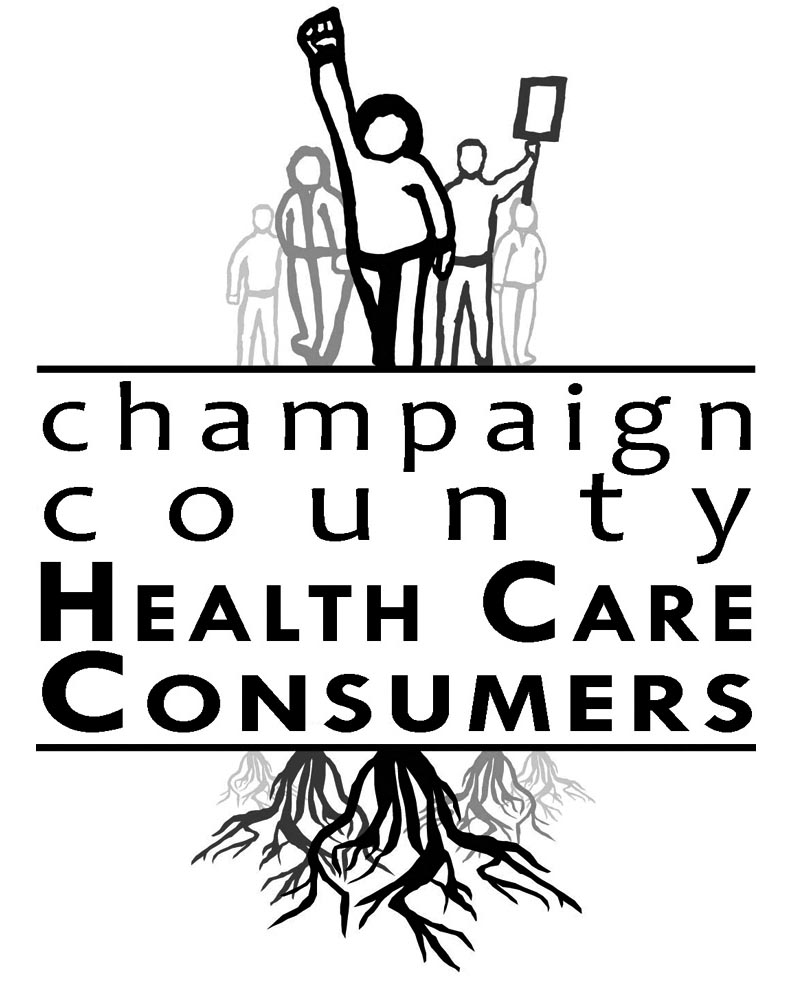By Champaign County Health Care Consumers’ Medical Billing Task Force
Key Findings About the Medical Debt Problem in Champaign County
These findings come from in-depth interviews of 30 Champaign County consumers who participated in the national study on medical debt which resulted in the report, The Consequences of Medical Debt: Evidence from Three Communities.
Who the consumers are:
• Most (60%) were ages 30 to 49 years old.
• Two-thirds were women.
Health insurance status:
• Half had health insurance at the time of the interview.
What consumers owe and to whom:
• Most consumers (72%) owed medical debt that was less than 5 years old.
• Almost 61% owed less than $5,000. 20% owed between $5,000 and $9,999. 14% owed between $10,000 and $19,999.
• 83% owed a hospital; 63% owed a clinic.
• Of those who owed the hospital, 68% owed for Emergency Room services.
• 70% owed to a collection agency. 76.7% had been contacted by a collection agency.
Payment arrangements:
• 60% were making payments on their debt at the time of interview.
• 69% had tried to arrange a payment plan with their health care provider.
• 56% were able to arrange some kind of payment plan, but almost 20% could not maintain payments on the plan because the payment amount was too high.
Financial impact on families due to medical debt:
• 40% reported having to borrow from family or friends to pay their medical bills.
• 56.7% reported being denied credit due to medical debt.
• 13% had been or were being sued for medical debt.
• 26.7% had filed for bankruptcy.
• 37% had to increase hours at work or take on another job to pay for medical debt.
• Medical debt affected families’ ability to:
– pay utility bills (63%)
– purchase prescription drugs (63%) – one-third stopped taking prescribed medications because they could not afford them
– buy clothing for children or themselves (70%)
– save money (83%)
– have entertainment (movies, etc.) or vacation time (77%)
How medical debt affects housing:
• Half said that medical debt affected their capacity to make rent or mortgage payments.
• 30% said they had been turned down from renting due to medical debt
• 26.7% said they were forced to move due to medical debt.
Psychological impact of medical debt:
• More than half (53%) said they had experienced depression because of medical debt.
• Half reported having stress and anxiety because of medical debt.
Denial of Care and Demands for Payment Upfront for Consumers with Medical Debt (p. 16)
• Champaign County’s health care providers, compared to the two other communities in the study, are more likely to use denial of care and to demand payment upfront in order to try to collect outstanding medical debt from low-income consumers.
• Respondents in Champaign were more likely to report that they were asked to pay cash upfront for health care services (59%) than respondents in Alexandria, VA (8%) and Miami, FL (33%)
• Respondents in Champaign were significantly more likely to be refused or delayed care (50%) compared to respondents in Alexandria, VA (32%) and Miami, FL (21%).
Local Bankruptcy Data
• There were 279 bankruptcy cases during the month of December 2001, and approximately 3,200 for the entire year.
• Approximately 58% of the studied bankruptcy data involved medical debt. This number does not include medical debt that was paid for with credit cards or by borrowing from a loan company. A greater proportion of bankruptcy filings in December 2001 in Central Illinois (58%) involved medical debt than the national average (40%) from 1999.
Small Claims Cases
• Between May and December 2001, small claims cases brought directly by health care providers in Champaign County numbered 229. This means that an average of 7 people per week were directly sued by health care providers in Champaign County small claims courts. This does not include medical debt lawsuits brought by collection agencies working on behalf of health care providers.
• About 20% of the small claims cases brought directly by health care providers were by non-profit health care providers.
• Health care providers were suing patients for balances as low as $100 in some cases. The average amount of debt for which the consumer was being sued in these cases was $997.38.
Policy Recommendations and Next Steps
What Health Care Providers Can Do Immediately to Address the Problem
• Cease the practice of denying access to care to people because of outstanding debt.
• Work with consumers to make reasonable payment agreements that are affordable to the consumer and realistic.
• Do not report medical debt to credit bureaus.
• Do not coerce or pressure patients to pay with credit cards or take out loans.
• Make financial and collections policies public.
• Treat people with dignity and respect. Also, ensure that collection agencies that health care providers contract with also treat people with dignity and respect.
The Medical Billing Task Force and the Community Health Partnership’s Access to Care Work Group will conduct a survey of health care providers’ financial policies.
• These two groups are joining together to ask local health care providers to answer a written survey about the health care providers’ financial policies.
• By completing the survey, health care providers will have an opportunity to make public their financial policies, as recommended above.
The Medical Billing Task Force and the Community Health Partnership’s Access to Care Work Group will solicit input from consumers and the community to develop additional policy recommendations regarding medical debt.
• Policy recommendations might take the form of addressing local health care providers’ practices, creating local ordinances, or advocating for state or federal legislation.

